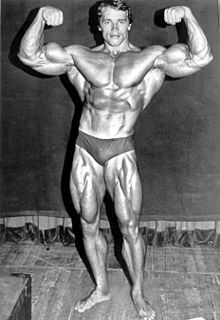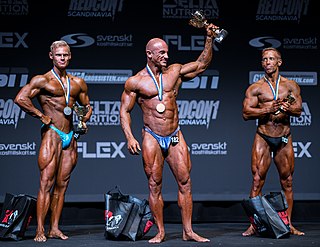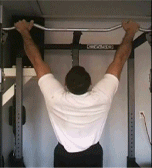Related Research Articles

Bodybuilding is the use of progressive resistance exercise to control and develop one's muscles by muscle hypertrophy for aesthetic purposes. It is distinct from similar activities such as powerlifting because it focuses on physical appearance instead of strength. An individual who engages in this activity is referred to as a bodybuilder. In professional bodybuilding, competitors appear in lineups and perform specified poses for a panel of judges who rank them based on symmetry, muscularity, size, conditioning, posing, and stage presentation. Bodybuilders prepare for competitions through the elimination of nonessential body fat, enhanced at the last stage by a combination of extracellular dehydration and carbo-loading, to achieve maximum muscular definition and vascularity; they also tan and shave to accentuate the contrast of their skin under the spotlights.

Weight training is a common type of strength training for developing the strength and size of skeletal muscles. It uses the force of gravity in the form of weighted bars, dumbbells or weight stacks in order to oppose the force generated by muscle through concentric or eccentric contraction. Weight training uses a variety of specialized equipment to target specific muscle groups and types of movement.
The muscular system is an organ system consisting of skeletal, smooth and cardiac muscles. It permits movement of the body, maintains posture and circulates blood throughout the body. The muscular systems in vertebrates are controlled through the nervous system although some muscles can be completely autonomous. Together with the skeletal system in the human, it forms the musculoskeletal system, which is responsible for movement of the body.

Skeletal muscles are organs of the vertebrate muscular system that are mostly attached by tendons to bones of the skeleton. The muscle cells of skeletal muscles are much longer than in the other types of muscle tissue, and are often known as muscle fibers. The muscle tissue of a skeletal muscle is striated – having a striped appearance due to the arrangement of the sarcomeres.
Muscle memory is a form of procedural memory that involves consolidating a specific motor task into memory through repetition, which has been used synonymously with motor learning. When a movement is repeated over time, a long-term muscle memory is created for that task, eventually allowing it to be performed with little to no conscious effort. This process decreases the need for attention and creates maximum efficiency within the motor and memory systems. Muscle memory is found in many everyday activities that become automatic and improve with practice, such as riding bicycles, driving motor vehicles, playing ball sports, typing on keyboards, entering PINs, playing musical instruments, poker, martial arts, and dancing.
Muscle fatigue is the decline in ability of muscles to generate force. It can be a result of vigorous exercise but abnormal fatigue may be caused by barriers to or interference with the different stages of muscle contraction. There are two main causes of muscle fatigue: the limitations of a nerve’s ability to generate a sustained signal ; and the reduced ability of the muscle fiber to contract.
High-intensity training (HIT) is a form of strength training popularized in the 1970s by Arthur Jones, the founder of Nautilus. The training focuses on performing quality weight training repetitions to the point of momentary muscular failure. The training takes into account the number of repetitions, the amount of weight, and the amount of time the muscle is exposed to tension in order to maximize the amount of muscle fiber recruitment.

Endurance is the ability of an organism to exert itself and remain active for a long period of time, as well as its ability to resist, withstand, recover from, and have immunity to trauma, wounds, or fatigue. It is usually used in aerobic or anaerobic exercise. The definition of 'long' varies according to the type of exertion – minutes for high intensity anaerobic exercise, hours or days for low intensity aerobic exercise. Training for endurance can reduce the ability to exert endurance strength unless an individual also undertakes resistance training to counteract this effect.

Strength training or resistance training involves the performance of physical exercises which are designed to improve strength and endurance. It is often associated with the use of weights. It can also incorporate a variety of training techniques such as calisthenics, isometrics, and plyometrics.

Plyometrics, also known as jump training or plyos, are exercises in which muscles exert maximum force in short intervals of time, with the goal of increasing power (speed-strength). This training focuses on learning to move from a muscle extension to a contraction in a rapid or "explosive" manner, such as in specialized repeated jumping. Plyometrics are primarily used by athletes, especially martial artists, sprinters, arm wrestlers and high jumpers, to improve performance, and are used in the fitness field to a much lesser degree.
Muscle weakness is a lack of muscle strength. Its causes are many and can be divided into conditions that have either true or perceived muscle weakness. True muscle weakness is a primary symptom of a variety of skeletal muscle diseases, including muscular dystrophy and inflammatory myopathy. It occurs in neuromuscular junction disorders, such as myasthenia gravis. Muscle weakness can also be caused by low levels of potassium and other electrolytes within muscle cells. It can be temporary or long-lasting. The term myasthenia is from my- from Greek μυο meaning "muscle" + -asthenia ἀσθένεια meaning "weakness".
Complex training, also known as contrast training or post-activation potentiation training, involves the integration of strength training and plyometrics in a training system designed to improve explosive power. According to Jace Derwin:
Strength training and plyometric training are both effective measures for increasing athletic performance independent of each other, but a true program designed for power-based athletes needs to incorporate both disciplines. A study done in 2000 in the NSCA's Journal of Strength and Conditioning Research measured three different training protocols: strength training, plyometric training, and a combination of both. The group that used combined methods was the only group that showed significant increases in BOTH strength and power.
A wall sit is an exercise done to strengthen the quadriceps muscles. A similar physical activity is known as the jetliner position. The exercise is characterized by the two right angles formed by the body, one at the hips and one at the knees. The person wall sitting places their back against a wall with their feet shoulder-width apart and a little ways out from the wall. Then, keeping their back against the wall, they lower their hips until their knees form right angles. This is a very intense work out for the quadriceps muscles and it can be very painful to hold this position for extended periods. Wall sits are used as a primary strengthening exercise in many sports requiring strong quadriceps like fencing, ice hockey, sailing, skiing and track and field. This exercise is also used as a disciplinary activity in the armed forces. It takes up little space, and can be administered easily in classroom settings to misbehaving soldiers-in-training.

A vertical jump or vertical leap is the act of jumping upwards into the air. It can be an exercise for building both endurance and strength, and is also a standard test for measuring athletic performance. It may also be referred to as a Sargent jump, named for Dudley Allen Sargent.

Progressive overload is a method of strength training that advocates for the gradual increase of the stress placed upon the musculoskeletal and nervous system. The principle of progressive overload suggests that the continual increase in the total workload during training sessions will stimulate muscle growth and strength gain. This improvement in overall performance will, in turn, allow the athlete to keep increasing the intensity of their training sessions.

Muscle hypertrophy or muscle building involves a hypertrophy or increase in size of skeletal muscle through a growth in size of its component cells. Two factors contribute to hypertrophy: sarcoplasmic hypertrophy, which focuses more on increased muscle glycogen storage; and myofibrillar hypertrophy, which focuses more on increased myofibril size. It is the most major part of the bodybuilding-related activities.

Bodyweight exercises are strength-training exercises that use an individual's own weight to provide resistance against gravity. Bodyweight exercises can enhance a range of biomotor abilities including strength, power, endurance, speed, flexibility, coordination and balance. Such strength training has become more popular among recreational and professional athletes. Bodyweight training uses simple abilities like pushing, pulling, squatting, bending, twisting and balancing. Movements such as the push-up, the pull-up, and the sit-up are among the most common bodyweight exercises.
Football strength is a training regime, considered the most complex physical quality to be developed by an athlete. The training regime, exercises used, how the exercises are performed, and the types of equipment all play important roles in achieving desired results.
Exercise-associated muscle cramps (EAMC) are defined as cramping during or immediately following exercise. Muscle cramps during exercise are very common, even in elite athletes. EAMC are a common condition that occurs during or after exercise, often during endurance events such as a triathlon or marathon. Although EAMC are extremely common among athletes, the cause is still not fully understood because muscle cramping can occur as a result of many underlying conditions. Elite athletes experience cramping due to paces at higher intensities. The cause of exercise-associated muscle cramps is hypothesized to be due to altered neuromuscular control, dehydration, or electrolyte depletion.
Central nervous system fatigue, or central fatigue, is a form of fatigue that is associated with changes in the synaptic concentration of neurotransmitters within the central nervous system which affects exercise performance and muscle function and cannot be explained by peripheral factors that affect muscle function. In healthy individuals, central fatigue can occur from prolonged exercise and is associated with neurochemical changes in the brain, primarily involving serotonin (5-HT), noradrenaline, and dopamine. Central fatigue plays an important role in endurance sports and also highlights the importance of proper nutrition in endurance athletes.
References
- ↑ Stefan Bircher, Sonja Keller Bircher (2014), Medical Fitness - Indikationsbezogene Übungen (in German) (3. ed.), Stuttgart: Haug, p. 35, ISBN 9783830476962
- 1 2 Norbert Oliver, Franz Marschall, Dirk Büsch (2008), Norbert Oliver und Ulrike Rockmann (ed.), Grundlagen der Trainingswissenschaft und -Lehre (Grundlagen der Sportwissenschaft) (in German), Schorndorf: hofmann, pp. 121f., ISBN 9783778091319 CS1 maint: multiple names: authors list (link)
- ↑ Günter Frey / Eberhard Hildenbrandt (1994), Ommo Gruppe (ed.), Einführung in die Trainingslehre Teil 1: Grundlagen (in German), 11, Schorndorf: Hofmann Verlag, pp. 80f., ISBN 3778084119